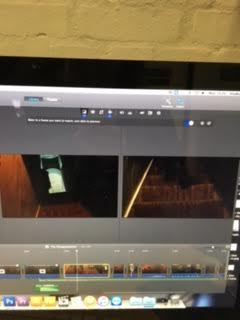To cohere to the conventions of a thriller movie we decided to use props, such as weapons, to give to our antagonist. However, we are also debating whether or not to let the victim also have a weapon. This would go against the typical conventions of our genre and would bring a unique aspect to our thriller.

Nikki, Libby and I wanted to make our antagonist fit the part, by dressing him in dark colours. We decided we wanted a black hoodie within our costume as this makes our intruder seem quite anonymous and mysterious. The colour black is often associated with with dark and evil things, as it brings forth a sinister atmosphere. In all crime thrillers I have analysed, the antagonist is either dressed in dark clothing to conform to the norm, or they can completely go against it. This is by making the antagonist seem like a normal civilian (usually dressed in smart clothing)- and therefore makes the audience feel even more scared of this character, as they realise they can be deceived by anyone. Because of this, we wanted to combine the elements of both of these. We thought that a hoodie is quite a casual piece of clothing that most people would wear, however, the black also brings an aspect of darkness to the character. Therefore ,we can make a connection between how our audience will be scared of the fact that anything can happen to them in the safety of their on homes, and how they can't trust anyone as they may turn out to be your worst nightmare.

When thinking into costume choices in detail, we decided that we wanted our antagonist to fit the part in every aspect. Wearing these type of shoes makes the antagonists feet look bulky. This overall makes him look dominant and controlling. This is also a typical shoe for intruders to wear, as they are very popular and are worn a lot by most individual's within our society, this means the police would find it harder to track down the antagonist just by evidence left behind (such as a foot print), as most people would have these shoes. Therefore, this once again makes our antagonist look like a smart and experienced killer.
Similar to the other costume choices, we decided that we wanted our antagonist to wear all black jeans. This is because it fits the costume and colour scheme, and overall works well together to form a typical antagonist.
We came to a consensus that we wanted to make our antagonist seem as anonymous and mysterious as possible. We throughout we would do this by including a black mask and black leather gloves into our antagonist costume. As well as gloves hiding evidence via finger prints and DNA, which makes the antagonist look smart and cunning, it also looks creepy, and lets the audience know that the antagonist is obviously planning a brutal attack. This is good at building suspense for the audience.

In regards to the victim character, we wanted her to look as weak as possible. This gives the audience the sense that her fate is sealed and builds suspense as they are then nervously waiting as to what will happen next. As you can see in this screen shot from the movie 'Mean Girls', the bedroom of Regina George s a typical girly room. To crate this atmosphere, my group and I are going to use candles, girly music, fluffy pillow and bright colours to put across the idea to our audience that our character conforms to the typical stereotypes of a young female victim. We want to make the audience feel as if our victim is in a safe, homely environment. This will cause our thriller to be much more effective, as it reminds the audience that no one , no where, is safe. Therefore we will use props such as candles, fluffy pillows and more.

The last two props we will use is a laptop and a phone. We decided we wanted to include these as they play a key role in making our thriller storyline make sense. Out victim is seen on the phone with her friend, and using her social media via her laptop to contact her boyfriend. It's also typical of a teenager to have these type of hardwares, meaning we are conforming to the stereotypes of youth representatives, therefore, making our character more convincing.

















